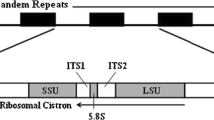Summary
Analysis of the 5S ribosomal RNA from members of the eubacterial order Planctomycetales, i.e.,Planctomyces, Pirella, Gemmata, andIsosphaera, reveals several unexpected features. Firstly, the primary structures are significantly shorter than those of the majority of eubacteria and vary in length between 109 and 111 nucleotides. Secondly, the lack of an insertion at position 66 is a feature not encountered before in prokaryotic 5S rRNAs. Thirdly, as compared to the proposed eubacterial “minimal” 5S rRNA structure (Erdmann and Wolters 1986) the secondary structure contains numerous basepair transversions. The isolated position of the planctomycetes as an individual eubacterial division and the phylogenetic position of its genera are in accord with the results obtained from 16S rRNA cataloguing.
Similar content being viewed by others
References
De Wachter R, Huysmans E, Vandenberghe A (1985) 5S ribosomal RNA as a tool for studying evolution. In: Schleifer KH, Stackebrandt E (eds) The evolution of prokaryotes. Academic Press, London, pp 115–141
Donis-Keller H, Maxam AM, Gilbert W (1977) Mapping adenines, guanines and pyrimidines in RNA. Nucleic Acids Res 8:2527–2537
Erdmann VA, Wolters J (1986) Collection of published 5S, 5.8S and 4.5S ribosomal RNA sequences. Nucleic Acids Res 14:r1-r59
Fitch WM, Margoliash E (1967) Construction of phylogenetic trees: a method based on mutation distances as estimated from cytochrome C sequences is of general applicability. Science 155:279–284
Franzmann P, Skerman VBD (1984)Gemmata obscuriglobus, a new genus and species of the budding bacteria. Antonie Leeuwenhoek Microbiol Serol 50:261–268
Giovannoni S, Schabtach E, Castenholz RW (1987)Isosphaera pallida, gen. and comb. nov., a gliding, budding eubacterium from hot springs. Arch Microbiol 147:276–284
Liesack W, König H, Schlesner H, Hirsch P (1986) Chemical composition of the peptidoglycan-free cell envelopes of budding bacteria of thePirella/Planctomyces group. Arch Microbiol 145:361–366
MacDonell MT, Colwell RR (1984) The nucleotide sequence of 5S ribosomal RNA fromVibrio marinus. Microbiol Sci 1: 229–231
Peattie DA (1984) Direct chemical method for sequencing RNA. Proc Natl Acad Sci USA 76:1760–1764
Schleifer KH, Kandler O (1972) Peptidoglycan types of bacterial cell walls and their taxonomic implications. Bacteriol Rev 36:407–477
Schlesner H (1986)Pirella marina sp. nov., a budding peptidoglycan-less bacterium from brackish water. Syst Appl Microbiol 8:177–180
Schlesner H, Stackebrandt E (1986) Assignment of the generaPlanctomyces andPirella to a new familyPlanctomycetales fam. nov. and description of the orderPlanctomycetales ord. nov. Syst Appl Microbiol 8:174–176
Stackebrandt E (1985) Phylogeny and phylogenetic classification of prokaryotes. In: Schleifer KH, Stackebrandt E (eds) The evolution of prokaryotes. Academic Press, London, pp 309–334
Stackebrandt E, Ludwig W, Schubert W, Klink F, Schlesner H, Roggentin T, Hirsch P (1984) Molecular genetic evidence for early evolutionary origin of budding peptidoglycan-less eubacteria. Nature 307:735–737
Stackebrandt E, Ludwig W, Fox GE (1985) 16S rRNA oligonucleotide cataloguing. Methods Microbiol 18:75–107
Stackebrandt E, Fischer A, Hirsch P, Roggentin T, Schlesner H (1986a) The phylogeny of an ancient group of budding peptidoglycan-less eubacteria: the generaPlanctomyces andPirella. Endocyt Cell Res 3:29–40
Stackebrandt E, Wehmeyer U, Liesack W (1986b) 16S rRNA analysis and chemistry of the cell wall ofGemmata obscuriglobus, a new member of the orderPlanctomycetales. FEMS Microbiol Lett 37:289–292
Weisburg WG, Hatch TP, Woese CR (1986) Eubacterial origin of chlamydiae. J Bacteriol 167:570–574
Woese CR, Olsen GJ (1986) Archaebacterial phylogeny: perspectives on urkingdoms. Syst Appl Microbiol 7:161–177
Woese CR, Stackebrandt E, Macke TJ, Fox GE (1985a) A definition of the major eubacterial taxa. Syst Appl Microbiol 6: 143–151
Woese CR, Stackebrandt E, Ludwig W (1985b) What are mycoplasmas: the relationship of tempo and mode in bacterial evolution. J Mol Evol 21:305–316
Wolters J, Erdmann VA (1986) Cladistic analyses of 5S rRNA and 16S rRNA secondary and primary structure—the evolution of eukaryotes and their relation to archaebacteria. J Mol Evol 24:152–166
Author information
Authors and Affiliations
Rights and permissions
About this article
Cite this article
Bomar, D., Giovannoni, S. & Stackebrandt, E. A unique type of eubacterial 5S rRNA in members of the order Planctomycetales. J Mol Evol 27, 121–125 (1988). https://doi.org/10.1007/BF02138371
Received:
Revised:
Issue Date:
DOI: https://doi.org/10.1007/BF02138371




